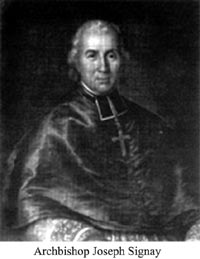Joseph Signay was born in Quebec on November 8, 1778 and studied in Quebec seminary. Ordained to the priesthood in Longueuil on March 28, 1802, he ministered as assistant or pastor in a number of parishes. On May 27, 1827 he was ordained bishop, coadjutor of Archbishop Bernard Claude Panet of Quebec whom he succeeded in 1833. In 1834, Bishop Pierre Flavien Turgeon (1787-1867) became his coadjutor. Archbishop Signay created parishes, had colleges and convents built, instituted pastoral and parish retreats, and promoted the establishment of religious Congregations in his diocese. Among other instituted he brought the Brothers of the Christian Schools, the Jesuits and the Oblates to Quebec.
Not long after the arrival of the Oblates in Canada, Bishop de Mazenod and Father Honorat wanted to have a foundation in Quebec, a diocese rich in vocations. On August 10, 1843, taking advantage of the death of a young man from Quebec in Marseilles, the Founder wrote to Archbishop Signay to inform him of “the most Christian death” of the young and he wrote also of the success of the Oblates in Montreal saying that his “ambition was tat the good they were doing should spread throughout Canada which they found so receptive to their message”. The letter was sent to Father Adrien Telmon, who had Bishop Ignace Bourget read it. The latter asked that it be not forwarded to Archbishop Signay. A letter from Father Honorat, dated October 23, 1842, will help to understand the reasoning behind Bishop Bourget’s request. “Quebec can only come later, because of the jealousy which exists that Montreal is getting ahead of them in everything. They would not want to be seen to imitate us.”
Nevertheless, less than one year later, on April 25, 1844, Archbishop Signay wrote to Father Honorat. He said that he had been told by Bishop Provencher, Apostolic Vicar of Hudson Bay and James Bay, that the Oblates were prepared to do in Quebec what they had done in Montreal”. He asked to have two Fathers during the summer so that each could accompany a diocesan priest in his visits to the Amerindians along the Saint-Maurice River ad the North Shore of the Saint-Lawrence, to the east of Quebec. Father Honorat agreed to do so in a letter dated April 28. Thrilled by the turn things had taken, he wrote to the Founder on the May 10, and 20 saying: “Quebec has come to us.”
At the beginning of May, Father Telmon accompanied Father Pierre Fisette to Quebec. The latter was about to depart with Father François Boucher of the diocesan clergy on a three-month expedition to visit the Montagnais of the Saguenay and the North Shore. The two priests were received “with fatherly kindness” by Bishop Turgeon in the absence of the archbishop. On June 8, Bishop de Mazenod wrote to Archbishop Signay saying that he would be pleased to send him some missionaries “who would devote themselves to the instruction of the native peoples (pauvres sauvages) in the diocese of Quebec. He noted that the Oblates were “essentially the bishop’s men and you can count on their dedication and their zeal which they always place at the disposal of your pastoral solicitude in everything that you choose to entrust to them.”
Father Honorat went to Quebec about May 20. He was well received by Archbishop Signay and Bishop Turgeon and he agreed to make a foundation in the autumn in Saguenay about 85 leagues from the city of Quebec to facilitate ministry among the colonists and the forest workers, but especially for the evangelization of the Montagnais. While visiting Quebec on August 13, Fathers Guigues and Honorat made the final arrangements for the establishment of the Oblates in Saint-Alexis on the Great Bay.
Archbishop Signay continued afterwards to maintain contact with Father Honorat and the missionaries. When fire destroyed part of the village of Saint-Alexis and of the other villages round about in 1846, he sent help immediately and arranged with the Governor General to have a boatload of provisions sent there. Soon, however, the archbishop became concerned with the activity of Father Honorat and his daring undertakings on behalf of the colonists, the debts he incurred for the building of chapels, his struggle against the monopoly of Mister McLeod and Mister Price, which had reduced the condition of the colonists and the forest workers to slavery. The archbishop preferred greater moderation and especially a better relationship with the powerful people in the area who, in spite of their flagrant injustices, were generous in the help provided for the building of churches and schools (See: Saint Alexis).
In 1849, Archbishop Signay and his coadjutor decided to send Father Honorat away from Saguenay and they asked Bishop Guigues to recall him to Montreal, “since he was no longer doing good in Saguenay”. In a letter dated September 25, 1849, Archbishop Signay gave to Father Flavien Durocher the powers that he had conferred on Father Honorat in 1844.
During the last years of his life, especially, Archbishop Signay avoided any intervention in political and national matters and he was opposed to any changes. In 1846, Bishop Bourget informed the Pope of the inertia of the administration of the archbishop, his inability to deal with important questions and the absence of connections with the suffragan bishops of Montreal, Toronto and Kingston. Archbishop Signay entrusted the administration of the diocese to Bishop Turgeon. He died on October 1, 1850.
Yvon Beaudoin, o.m.i.

